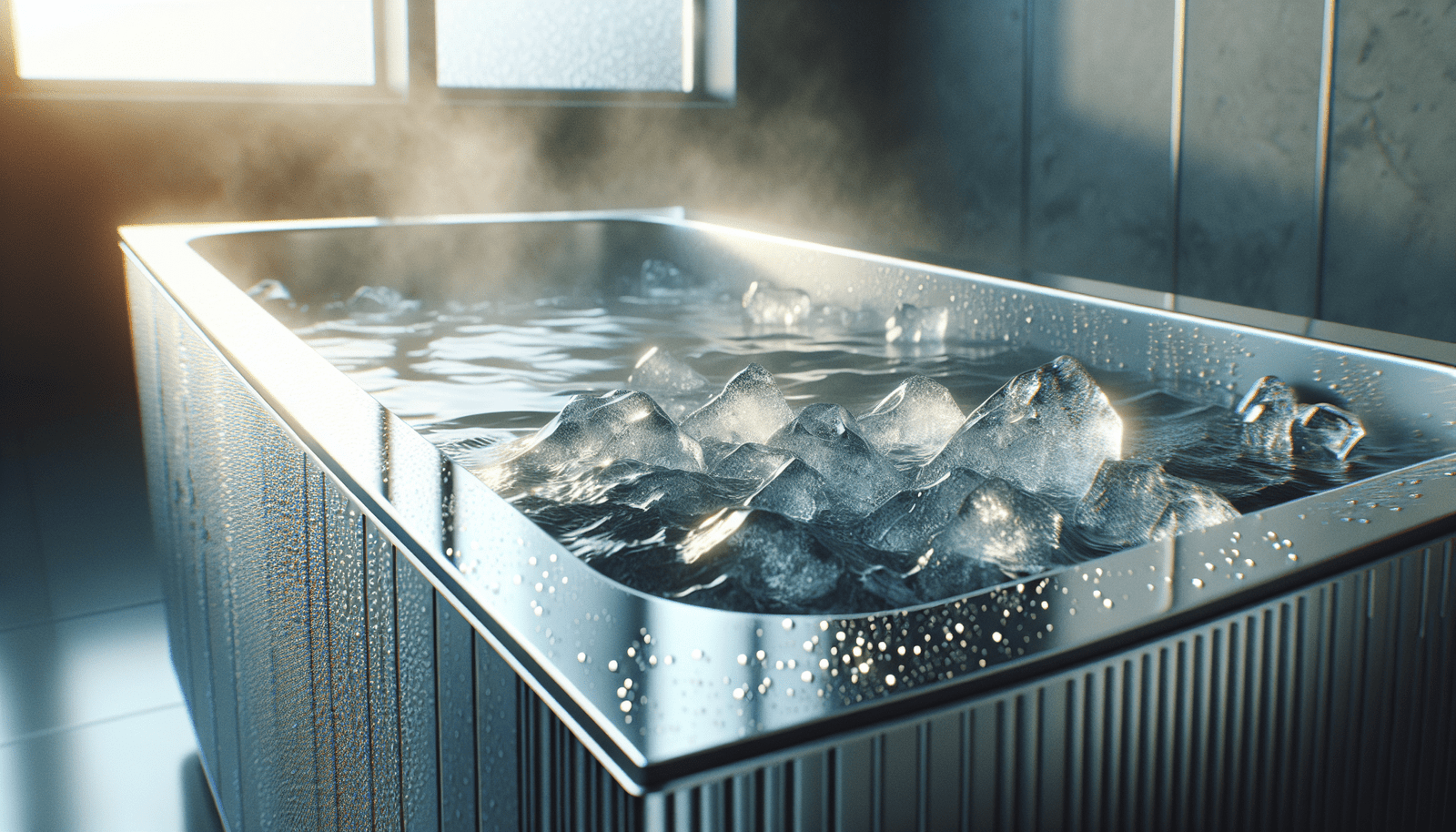Welcome to the Athlete Recovery Masterclass where you will learn all about the art of cold plunges. In this article, we will explore the benefits of cold water therapy for athletes, how to properly and safely conduct a cold plunge, and tips for maximizing your recovery potential. Get ready to take your post-workout routine to the next level with this invigorating and rejuvenating practice.
Athlete Recovery Masterclass: The Art Of Cold Plunges
Have you ever wondered about the benefits of cold plunges for athlete recovery? In this masterclass, we will explore the art of cold plunges and how they can help you recover faster and perform better in your sport. Whether you’re a professional athlete or a weekend warrior, incorporating cold plunges into your recovery routine can make a significant difference in your overall performance. Let’s dive in and learn more about this powerful recovery tool.
What Are Cold Plunges?
Cold plunges, also known as cold water immersion or cryotherapy, involve exposing your body to cold water or ice baths for a specific period. This practice has been used for centuries to promote healing, reduce inflammation, and enhance recovery. The cold water causes blood vessels to constrict, which helps flush out metabolic waste and reduce swelling in muscles.
Cold plunges can be done in various ways, including full-body immersion in a tub of ice water or standing in a cold shower. Many athletes swear by the benefits of cold plunges for reducing muscle soreness, improving circulation, and speeding up recovery time.
Benefits of Cold Plunges for Athlete Recovery
Cold plunges offer a wide range of benefits for athlete recovery, both physically and mentally. Here are some of the key benefits you can expect from incorporating cold plunges into your recovery routine:
- Reduced Muscle Soreness: Cold plunges help decrease inflammation and muscle soreness by constricting blood vessels and reducing swelling in muscles.
- Faster Recovery: Cold plunges promote faster recovery by flushing out metabolic waste and improving circulation, allowing your body to repair and regenerate muscle tissue more effectively.
- Improved Performance: By enhancing recovery, cold plunges can help you perform better in your sport and maintain peak physical condition.
- Mental Clarity: Cold plunges have been shown to improve mental focus and clarity, helping athletes stay sharp and focused during training and competition.
Incorporating cold plunges into your athlete recovery routine can have a profound impact on your overall performance and well-being. Let’s explore some practical tips for making the most of this powerful recovery tool.
Tips for Incorporating Cold Plunges into Your Recovery Routine
If you’re new to cold plunges or looking to optimize your existing routine, here are some tips to help you make the most of this powerful recovery tool:
- Start Slow: If you’re new to cold plunges, start with shorter durations and gradually increase the time as your body adapts to the cold.
- Stay Consistent: To reap the full benefits of cold plunges, consistency is key. Aim to incorporate cold plunges into your recovery routine on a regular basis.
- Experiment with Temperatures: Experiment with different water temperatures to find what works best for you. Some athletes prefer ice-cold water, while others find a slightly warmer temperature more comfortable.
- Combine with Contrast Therapy: Consider combining cold plunges with contrast therapy, alternating between hot and cold water immersion to enhance circulation and recovery.
- Listen to Your Body: Pay attention to how your body responds to cold plunges and adjust your routine accordingly. If you experience any pain or discomfort, consult with a medical professional.
By following these tips and listening to your body, you can maximize the benefits of cold plunges for athlete recovery and take your performance to the next level. Let’s explore some of the best practices for incorporating cold plunges into your routine.
Best Practices for Cold Plunges
When it comes to cold plunges, there are several best practices to keep in mind to ensure a safe and effective recovery experience. Here are some tips for making the most of your cold plunge sessions:
- Hydrate Before and After: Drink plenty of water before and after your cold plunge to stay hydrated and support muscle recovery.
- Warm-Up Before: Perform a light warm-up before your cold plunge session to prepare your muscles and prime your body for the cold.
- Ease Into It: When entering the cold water, take slow, deep breaths and focus on relaxing your body to help acclimate to the temperature.
- Monitor Duration: Pay attention to how long you stay in the cold water and gradually increase the time as you become more accustomed to the cold.
- Follow with Warmth: After your cold plunge, wrap yourself in warm layers and allow your body to gradually warm up to prevent hypothermia.
By following these best practices, you can ensure a safe and effective cold plunge experience that maximizes the benefits for athlete recovery. Let’s dive deeper into the science behind cold plunges and how they impact your body.
The Science Behind Cold Plunges
Cold plunges work by triggering a physiological response in your body known as cold shock, which has a range of beneficial effects on your muscles, circulation, and overall recovery. When you expose your body to cold water, several key mechanisms are activated:
- Vasoconstriction: Cold water causes blood vessels to constrict, reducing blood flow to muscles and decreasing inflammation and pain.
- Metabolic Response: Your body’s metabolic rate increases in response to the cold, facilitating the flushing out of metabolic waste and toxins.
- Hormonal Release: Cold plunges stimulate the release of endorphins and other feel-good hormones, which can help reduce stress and improve mood.
- Immune Boost: Cold water exposure has been shown to boost immunity by increasing white blood cell count and activating anti-inflammatory pathways.
By understanding the science behind cold plunges, you can optimize your recovery routine and make the most of this powerful tool for enhancing performance and well-being. Let’s explore some common misconceptions about cold plunges and debunk them once and for all.
Debunking Common Misconceptions About Cold Plunges
There are several myths and misconceptions surrounding cold plunges and their impact on athlete recovery. Let’s debunk some of the most common misconceptions and set the record straight:
- Myth: Cold Plunges are Only for Serious Athletes: Cold plunges can benefit athletes of all levels, from beginners to elite professionals. Anyone can benefit from the recovery-enhancing effects of cold water immersion.
- Myth: Cold Plunges Cause Hypothermia: While prolonged exposure to cold water can lead to hypothermia, when done safely and in controlled conditions, cold plunges are a safe and effective recovery tool.
- Myth: Cold Plunges are Uncomfortable: While cold plunges can be initially shocking to the system, many athletes find them invigorating and energizing once they acclimate to the cold water.
- Myth: Cold Plunges are a Fad: Cold water immersion has been used for centuries as a healing practice, and its benefits for recovery are supported by scientific research and empirical evidence.
By dispelling these common misconceptions, you can feel more confident in incorporating cold plunges into your athlete recovery routine and reaping the benefits for your performance and well-being. Let’s explore some additional strategies for optimizing your cold plunge sessions.
Advanced Strategies for Optimizing Cold Plunges
If you’re looking to take your cold plunge routine to the next level, consider implementing some advanced strategies to enhance the effectiveness of your recovery sessions:
- Breathing Techniques: Practice deep diaphragmatic breathing during your cold plunge to help calm your nervous system and improve circulation.
- Meditation and Visualization: Use meditation and visualization techniques to stay relaxed and focused during your cold plunge, enhancing the mental benefits of the practice.
- Cryotherapy Devices: Consider investing in cryotherapy devices, such as cold water immersion tanks or cryo-chambers, for a more controlled and consistent cold plunge experience.
- Post-Plunge Nutrition: Follow up your cold plunge with a nutritious post-recovery meal or snack to replenish energy stores and support muscle repair.
- Recovery Modalities: Combine cold plunges with other recovery modalities, such as foam rolling, stretching, or massage, to create a comprehensive recovery routine.
By incorporating these advanced strategies into your cold plunge routine, you can maximize the benefits of cold water immersion for athlete recovery and take your performance to new heights. Let’s wrap up our masterclass with some final thoughts on the art of cold plunges and their transformative effects on athlete recovery.
Final Thoughts: Embracing the Art of Cold Plunges
In conclusion, cold plunges offer a powerful and effective tool for enhancing athlete recovery and improving performance. By understanding the science behind cold water immersion, dispelling common misconceptions, and implementing best practices and advanced strategies, you can optimize your cold plunge routine and experience the full range of benefits for your physical and mental well-being.
Whether you’re a competitive athlete looking to gain a competitive edge or a fitness enthusiast seeking to recover faster and perform better, cold plunges can be a game-changer in your recovery routine. Embrace the art of cold plunges, experiment with different temperatures and techniques, and listen to your body to discover the transformative effects of this ancient practice.
Get ready to take your athlete recovery to the next level with the art of cold plunges. Are you up for the challenge? Dive in and experience the rejuvenating power of cold water immersion for yourself. Your body and mind will thank you.





